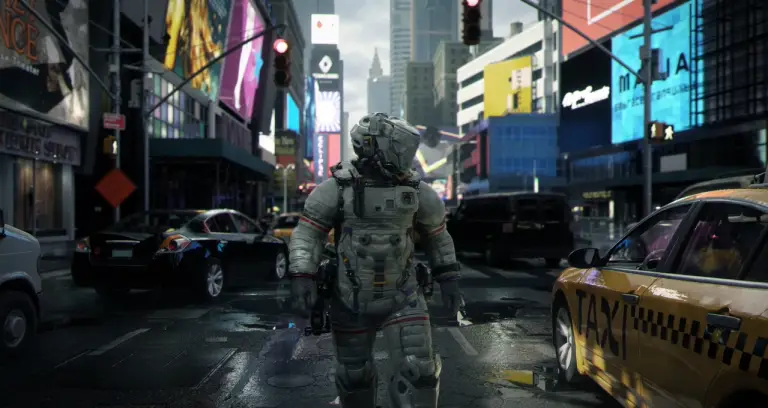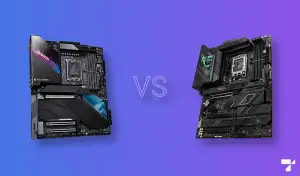Since the PlayStation 5 was launched on November 12, 2020, Sony has done an excellent job showcasing the graphical capabilities of its next-gen console. Whether it’s through a literal showcase or a game like Ratchet & Clank: Rift Apart, at this point, the massive improvement of the PS5 graphics compared to previous generation consoles such as the PS4 can not be denied.
Therefore, below, we’ll go deeper into everything that you need to know about the PS5 graphics. This includes the graphics card that Sony used to achieve the kind of performance that the PS5 has and what its PC equivalent is, among others
What Graphics Card is Used in the PS5?
The stunning and beautiful PS5 graphics is owed to the heavily customized RDNA 2 GPU from AMD that’s found under its hood. It packs 10.28T teraflops of computing power, along with 36 computer units. The GPU is also clocked at 2.23GHz and supports ray tracing, as well as native 4K gaming at 120 FPS. Though this varies depending on the specific gaming title and how well it is optimized for the PS5 by its developers.
PS5 GPU Specs
- GPU Architecture: Custom AMD RDNA 2
- Teraflops: 10.28
- Compute Units: 36
- GPU Clock: 2.23GHz
You can learn more about the PS5 graphical specifications here.
What Does Higher Teraflops Mean for the PS5 Graphics?
A teraflop is a unit of measure for calculating the speed of a computer equal to one trillion floating-point operations per second. But, in an attempt to keep things simple, a teraflop is, in a very simplified sense, what determines just how fast a graphics card is. The more teraflops a graphics card has, the more powerful a console is and the more realistic and aesthetically pleasing the graphics on the screen will be.
What this means is that the considerable increase of 10.28 teraflops found in the GPU of the PS5 compared to the 4.2 of the PS4 Pro has greatly increased its graphical speed and performance when compared to previous-gen consoles.
But of course, graphical fidelity still very much depends on how developers make use of the greatly increased graphical power. With higher teraflops, gaming studios have more to play with. So with the increased teraflops and computing units, the PS5 delivers much better graphical performance compared to the previous generation of consoles.
PS5 Graphical Performance
It’s no secret that PS5 graphics is a massive improvement over the PS4 graphics. This is simply due to having more powerful and efficient hardware.
The PS5 has a custom APU from AMD integrated to run the show. As previously mentioned, the graphics card of that APU uses a heavily customized RDNA 2 architecture with 10.28 teraflops, and 36 Compute Units running at a max boost clock of 2.23GHz. This allows the PS5 to produce a graphically stunning performance on consoles only the Xbox Series X can rival. In fact, the PS5 can now support games in native 4K resolutions at 120 FPS.
Sony also released an update that makes the PS5 games look even better. The over-air update pertaining to Variable Refresh Rate (VRR) dynamically syncs the refresh rate of the PS5’s graphical output to the display. Which allows for even smoother and crisper visuals.
In games like Returnal, Ratchet & Clank: Rift Apart, and Final Fantasy VII Remake: Intergrade, the differences are much more pronounced than expected. Even at first glance, it’s easy to tell just how much better a game made specifically for the PS5 looks.
In the video above, for example, we can see how the PS5-exclusive Final Fantasy VII Remake: Intergrade compares to the PS4’s 2020 Final Fantasy VII Remake. The PS4 version might have already looked great, but the PS5 version takes things to a whole other level.
It doesn’t matter which of the Quality and Performance Modes you run Final Fantasy VII Remake, the game looks and plays significantly better on the PS5. It’s not just a matter of resolution either, although the difference there is also substantial. The game runs at a native 4K resolution in the game’s Graphics Mode and drops to 1872p in Performance Mode, which is still higher compared to the maximum resolution of the PS4 Pro.
Because of the improved hardware, the PS5 graphics of Final Fantasy VII Remake fixes all the previous issues with the PS4 and PS4 Pro. The infamous “door” texture is no longer there, with the higher memory allocation of the PS5 allowing the console to load even the most minute details in the scenery in 4K.
The video above is another good example. It compares the graphics of the PS4 game, Horizon Zero Dawn, on the PlayStation 4 Pro, to that of its sequel, Horizon Forbidden West, on the PlayStation 5. If we’re being modest, the original was one of the most beautiful games on the PlayStation 4.
Unlike other games released before it that banked on its graphics, Horizon Zero Dawn actually delivered. The final product looked just as good as the one that was showcased in its original reveal. But, as good as Horizon Zero Dawn may have looked, the trailer that was showcased as part of Sony’s show was just breathtaking.
From the highly improved water simulation to the insane details in close-up shots, as well as how much more dense vegetation and foliage seemed with a better rendering of the environment, as well as lighting, to boot, it’s no wonder many claims that Horizon Forbidden West was the highlight of the showcase.
Fast forward to nearly a year later and Sony provided a better glimpse of how Horizon Forbidden West will perform on the PS5. Although the changes to how the protagonist, Aloy, looked on the PS5 received criticism, Forbidden West on the PS5 is shaping up to be one of the most beautiful games ever made. Mind you, this is while still using the same old engine that Horizon Zero Dawn used.
While it’s true that older textures will definitely look better when played on the PlayStation 5, the fact remains that we won’t see games truly reflect what the PS5 graphics can do until developers create a new engine specifically developed for the next-generation consoles. We already saw what Epic was able to do with Unreal Engine 5.
Now, all that’s left is for other gaming developers and studios to produce more truly visually stunning games with improved performance in terms of resolution and FPS.
What is the PS5 GPU equivalent?
The PS5 equivalent GPU is the RX 5700 XT from AMD and the Geforce RTX 2070 Super from Nivida based mainly on teraflops and gaming at the same resolutions, frame rates, and graphical settings.
Compared to the PS5’s 10.28 TFLOPs, the RX 5700 XT has 9.75 TFLOPS and the RTX 2700 Super has 9.1 TFLOPS placing them extremely close to the PS5 in that category. The 5700 XT also has 40 compute units compared to the 36 of the PS5. Therefore, disregarding the architectural design differences between the PS5 and a PC, these two GPUs are the closest in terms of graphical performance.
However, in terms of real-world performance, there are many varying factors that may lead these two GPUs to perform significantly better than the PS5’s GPU. However, given the high price of these GPUs let alone the cost of building a full PC with them, the PS5 console is a vastly cheaper alternative. Though on the other hand you can do a lot more with a PC than just gaming and consuming content. Learn more about the PS5 GPU equivalent.
PS5 vs Xbox Series X Graphics
On paper, PS5 graphics should not be as good as that of the Xbox Series X. In terms of teraflops, the Xbox Series X has more at 12 while the PlayStation 5 has about 10. In nominal terms, that’s roughly an extra PlayStation 4 or Xbox One worth of computing power that the Xbox Series X has over the PlayStation 5. The Xbox Series X also has more compute units at 52 compared to the 36 of the PS5.
However, it is important to keep in mind that the GPUs of both consoles are based on the same architecture. This means that the improvements, though big on paper, are not as drastic as in real-life graphical performance for the Xbox Series X when compared to the PS5. Though the Xbox Series X graphics do seem to be slightly better out of the box in some titles when compared to the PS5 graphics.
PS5 vs PS4 Graphics
The standard PlayStation 4 only has 1.8 teraflops of computing power. The upgraded version, the PlayStation 4 Pro, has more than double at 4.2 teraflops. As mentioned earlier, the PS5 has 10.28 teraflops.
It’s worth noting that the PS4 Pro can currently render either 4K resolution at 30 FPS or 1080p resolution at 60FPS. Also, the PS4 Pro does not support native 4K, but instead, uses an optical illusion more commonly known as checkerboarding, to give the illusion that what you’re playing is being rendered at a 4K resolution.
With more than twice the computing power of the PlayStation 4 Pro, the PlayStation 5 can easily support native 4K and even 8K resolution, as well as higher frame rates.
What developers usually do is give players options on the PS5. For example, in games like Demon’s Souls, players can choose the Cinematic Mode to run the game at a native 4K resolution at the expense of capping the frame rates at 30 frames per second. Meanwhile, in Performance Mode, Demon’s Souls runs at a lower resolution of just 1440p in exchange for frame rates as high as 60 frames per second.
Another example is in Final Fantasy VII Remake: Intergrade. Even though both the Graphics and Performance Mode runs the game at 4K resolution, the former uses a native 4K resolution. On the other hand, the latter uses Dynamic 4K, which means that it will lower the resolution when necessary to achieve the target frame rate of 60 frames per second.
Final Thoughts
Overall, the PS5 is currently the second most advanced console in the world behind the Xbox Series X when it comes to graphics, if not on par with it. Due to its hardware upgrades compared to previous generations, the graphics of the PS5 has been taken to another level of 4K native resolution at 120 FPS which was previously unthinkable on a console.



